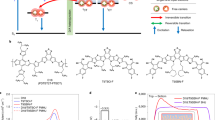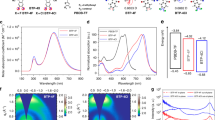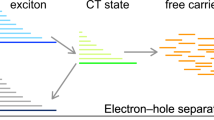Abstract
Photoconversion in planar-heterojunction organic photovoltaic cells (OPVs) is limited by a short exciton diffusion length (LD) that restricts migration to the dissociating electron donor/acceptor interface. Consequently, bulk heterojunctions are often used to realize high efficiency as these structures reduce the distance an exciton must travel to be dissociated. Here, we present an alternative approach that seeks to directly engineer LD by optimizing the intermolecular separation and consequently, the photophysical parameters responsible for excitonic energy transfer. By diluting the electron donor boron subphthalocyanine chloride into a wide-energy-gap host material, we optimize the degree of interaction between donor molecules and observe a ~50% increase in LD. Using this approach, we construct planar-heterojunction OPVs with a power conversion efficiency of (4.4 ± 0.3)%, > 30% larger than the case of optimized devices containing an undiluted donor layer. The underlying correlation between LD and the degree of molecular interaction has wide implications for the design of both OPV active materials and device architectures.
This is a preview of subscription content, access via your institution
Access options
Subscribe to this journal
Receive 12 print issues and online access
$259.00 per year
only $21.58 per issue
Buy this article
- Purchase on Springer Link
- Instant access to full article PDF
Prices may be subject to local taxes which are calculated during checkout




Similar content being viewed by others
References
Tang, C. W. 2-layer organic photovoltaic cell. Appl. Phys. Lett. 48, 183–185 (1986).
Gregg, B. A. Excitonic solar cells. J. Phys. Chem. B 107, 4688–4698 (2003).
Sun, Y. et al. Solution-processed small-molecule solar cells with 6.7% efficiency. Nature Mater. 11, 44–48 (2012).
Peumans, P., Uchida, S. & Forrest, S. R. Efficient bulk heterojunction photovoltaic cells using small-molecular-weight organic thin films. Nature 425, 158–162 (2003).
Liang, Y. et al. For the bright future—bulk heterojunction polymer solar cells with power conversion efficiency of 7.4%. Adv. Mater. 22, E135–E138 (2010).
He, Z. et al. Simultaneous enhancement of open-circuit voltage, short-circuit current density, and fill factor in polymer solar cells. Adv. Mater. 23, 4636–4643 (2011).
Fitzner, R. et al. Dicyanovinyl-substituted oligothiophenes: Structure-property relationships and application in vacuum-processed small-molecule organic solar cells. Adv. Funct. Mater. 21, 897–910 (2011).
Yu, G., Gao, J., Hummelen, J. C., Wudl, F. & Heeger, A. J. Polymer photovoltaic cells: Enhanced efficiencies via a network of internal donor-acceptor heterojunctions. Science 270, 1789–1791 (1995).
Halls, J. J. M. et al. Efficient photodiodes from interpenetrating polymer networks. Nature 376, 498–500 (1995).
Wei, G. et al. Arylamine-based squaraine donors for use in organic solar cells. Nano Lett. 11, 4261–4264 (2011).
Yang, F., Sun, K. & Forrest, S. R. Efficient solar cells using all-organic nanocrystalline networks. Adv. Mater. 19, 4166–4171 (2007).
Luhman, W. A. & Holmes, R. J. Enhanced exciton diffusion in an organic photovoltaic cell by energy transfer using a phosphorescent sensitizer. Appl. Phys. Lett. 94, 153304 (2009).
Rand, B. P. et al. Photocurrent enhancement in polymer: fullerene bulk heterojunction solar cells doped with a phosphorescent molecule. Appl. Phys. Lett. 95, 173304 (2009).
Lunt, R. R., Benziger, J. B. & Forrest, S. R. Relationship between crystalline order and exciton diffusion length in molecular organic semiconductors. Adv. Mater. 22, 1233–1236 (2010).
Najafov, H., Lee, B., Zhou, Q., Feldman, L. C. & Podzorov, V. Observation of long-range exciton diffusion in highly ordered organic semiconductors. Nature Mater. 9, 938–943 (2010).
Powell, R. C. & Soos, Z. G. Singlet exciton energy transfer in organic solids. J. Lumin. 11, 1–45 (1975).
Förster, T. 10th Spiers Memorial Lecture. Transfer mechanisms of electronic excitation. Discuss. Faraday Soc. 27, 7–17 (1959).
Pope, M. & Swenberg, C. E. Electronic Processes in Organic Crystals (Oxford Univ. Press, 1982).
Luhman, W. A. & Holmes, R. J. Investigation of energy transfer in organic photovoltaic cells and impact on exciton diffusion length measurements. Adv. Funct. Mater. 21, 764–771 (2011).
Maksimov, M. Z. & Rozman, I. M. On energy transfer in solid solutions. Opt. Spectrosc. 12, 337–338 (1962).
Kawamura, Y. et al. 100% phosphorescence quantum efficiency of Ir(III) complexes in organic semiconductor films. Appl. Phys. Lett. 86, 071104 (2005).
Coffey, D. C., Ferguson, A. J., Kopidakis, N. & Rumbles, G. Photovoltaic charge generation in organic semiconductors based on long-range energy transfer. ACS Nano 4, 5437–5445 (2010).
Hardin, B. E. et al. Increased light harvesting in dye-sensitized solar cells with energy relay dyes. Nature Photon. 3, 406–411 (2009).
Currie, M. J., Mapel, J. K., Heidel, T. D., Goffri, S. & Baldo, M. A. High-efficiency organic solar concentrators for photovoltaics. Science 321, 226–228 (2008).
Pettersson, L. A. A., Roman, L. S. & Inganas, O. Modeling photocurrent action spectra of photovoltaic devices based on organic thin films. J. Appl. Phys. 86, 487–496 (1999).
Holmes, R. J. et al. Efficient, deep-blue organic electrophosphorescence by guest charge trapping. Appl. Phys. Lett. 83, 3818–3820 (2003).
Scully, S. R., Armstrong, P. B., Edder, C., Frechet, J. M. J. & McGehee, M. D. Long-range resonant energy transfer for enhanced exciton harvesting for organic solar cells. Adv. Mater. 19, 2961–2966 (2007).
Gommans, H. et al. Electro-optical study of subphthalocyanine in a bilayer organic solar cell. Adv. Funct. Mater. 17, 2653–2658 (2007).
Pandey, R., Gunawan, A. A., Mkhoyan, K. A. & Holmes, R. J. Efficient organic photovoltaic cells based on nanocrystalline mixtures of boron subphthalocyanine chloride and C60. Adv. Funct. Mater. 22, 617–624 (2011).
Lunt, R. R., Giebink, N. C., Belak, A. A., Benziger, J. B. & Forrest, S. R. Exciton diffusion lengths of organic semiconductor thin films measured by spectrally resolved photoluminescence quenching. J. Appl. Phys. 105, 053711 (2009).
Sullivan, P. et al. Halogenated boron subphthalocyanines as light harvesting electron acceptors in organic photovoltaics. Adv. Energy Mater. 1, 352–355 (2011).
Cheyns, D., Rand, B. P. & Heremans, P. Organic tandem solar cells with complementary absorbing layers and a high open-circuit voltage. Appl. Phys. Lett. 97, 033301 (2010).
Mutolo, K. L., Mayo, E. I., Rand, B. P., Forrest, S. R. & Thompson, M. E. Enhanced open-circuit voltage in subphthalocyanine/C-60 organic photovoltaic cells. J. Am. Chem. Soc. 128, 8108–8109 (2006).
Pandey, R., Zou, Y. & Holmes, R. J. Efficient, bulk heterojunction organic photovoltaic cells based on boron subphthalocyanine chloride-C-70. Appl. Phys. Lett. 101, 033308 (2012).
Gilot, J., Barbu, I., Wienk, M. M. & Janssen, R. A. J. The use of ZnO as optical spacer in polymer solar cells: Theoretical and experimental study. Appl. Phys. Lett. 91, 113520 (2007).
Schueppel, R. et al. Controlled current matching in small molecule organic tandem solar cells using doped spacer layers. J. Appl. Phys. 107, 044503 (2010).
Scher, H. & Lax, M. Stochastic transport in a disordered solid. I. theory. Phys. Rev. B 7, 4491-4502 (1973).
Gommans, H., Schols, S., Kadashchuk, A., Heremans, P. & Meskers, S. C. J. Exciton diffusion length and lifetime in subphthalocyanine films. J. Phys. Chem. C 113, 2974–2979 (2009).
Bulovic, V., Deshpande, R., Thompson, M. E. & Forrest, S. R. Tuning the color emission of thin film molecular organic light emitting devices by the solid state solvation effect. Chem. Phys. Lett. 308, 317–322 (1999).
Rieger, P. T., Palese, S. P. & Miller, R. J. D. On the Forster model: Computational and ultrafast studies of electronic energy transport. Chem. Phys. 221, 85–102 (1997).
Fennel, F. & Lochbrunner, S. Long distance energy transfer in a polymer matrix doped with a perylene dye. Phys. Chem. Chem. Phys. 13, 3527–3533 (2011).
Yuichiro, K., Hiroyuki, S. & Chihaya, A. Simple accurate system for measuring absolute photoluminescence quantum efficiency in organic solid-state thin films. Jpn. J. Appl. Phys. 43, 7729–7730 (2004).
Acknowledgements
This work was supported primarily by the National Science Foundation (NSF) Program in Solid State and Materials Chemistry (DMR-1006566). Partial support was also received from the University of Minnesota NSF Materials Research Science and Engineering Center (DMR-0819885) and the University of Minnesota Initiative for Renewable Energy and the Environment. The authors wish to acknowledge helpful discussions with D. A. Blank.
Author information
Authors and Affiliations
Contributions
S.M.M., W.A.L. and R.J.H. conceived the experiments. S.M.M. and W.A.L. fabricated the structures and carried out the measurements. S.M.M., W.A.L. and R.J.H. contributed to the analysis, and S.M.M. and R.J.H. wrote the manuscript.
Corresponding author
Ethics declarations
Competing interests
The authors declare no competing financial interests.
Supplementary information
Supplementary Information
Supplementary Information (PDF 348 kb)
Rights and permissions
About this article
Cite this article
Menke, S., Luhman, W. & Holmes, R. Tailored exciton diffusion in organic photovoltaic cells for enhanced power conversion efficiency. Nature Mater 12, 152–157 (2013). https://doi.org/10.1038/nmat3467
Received:
Accepted:
Published:
Issue Date:
DOI: https://doi.org/10.1038/nmat3467
This article is cited by
-
Directed exciton transport highways in organic semiconductors
Nature Communications (2023)
-
Self-filtering narrowband high performance organic photodetectors enabled by manipulating localized Frenkel exciton dissociation
Nature Communications (2020)
-
Orientation dependent molecular electrostatics drives efficient charge generation in homojunction organic solar cells
Nature Communications (2020)
-
Unraveling the influence of non-fullerene acceptor molecular packing on photovoltaic performance of organic solar cells
Nature Communications (2020)
-
Intrinsic measurements of exciton transport in photovoltaic cells
Nature Communications (2019)



